Inspired by organic cells, with some marvellous art on show, the Gold Coast's new HOTA Gallery is a triumph
- Written by Chari Larsson, Lecturer of art history, Griffith University
The new $60.5 million HOTA Gallery opened its doors on the weekend, updating ageing infrastructure and marking an exciting chapter for the Gold Coast.
HOTA, or Home of the Arts, has been developed as part of a masterplan begun almost a decade ago by the Gold Coast Council to rework a 17-hectare site into a vibrant arts and entertainment precinct. Nestled just in front of the gallery is a $37.5 million outdoor stage.
Designed by Melbourne-based architects ARM, the HOTA Gallery signals a democratic and inclusive vision for both residents and visiting tourists.
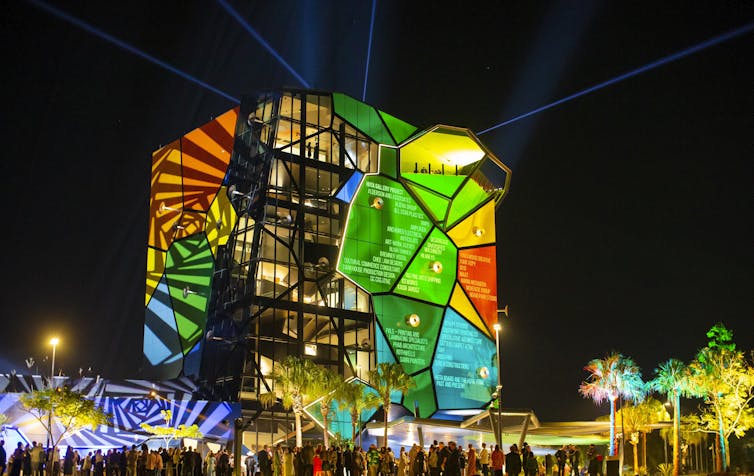 The architecture takes inspiration from Voronoi tessellations which occur throughout nature.
HOTA
The architecture takes inspiration from Voronoi tessellations which occur throughout nature.
HOTA
The architecture firm used the cellular structure of the Voronoi diagram as an organisational and visual metaphor for the precinct. Voronoi tessellations occur throughout nature and are a puzzle-like collection of cells fitting together: imagine honeycomb; veins on a dragonfly’s wings and the natural patterns of a giraffe’s fur.
Eschewing the vertical lines of nearby apartment buildings and hotels — the popular images of the Gold Coast — HOTA’s facade instead resembles a colourful clumping of organic cells.
It is welcoming and playful, reflecting the relaxed ethos of inclusivity underpinning the council’s vision for the precinct.
 The space is welcoming and playful.
HOTA
The space is welcoming and playful.
HOTA
The gallery itself is six floors high, and the top floor flaunts views to the east of the Gold Coast skyline. To the west is the dramatic hinterland and scenic rim; with riverside parklands below. Cleverly, the cell-like windows yield an abundance of natural light without compromising the exhibition spaces.
Walking around the gallery, I am reminded of the critical role local councils play in creating arts spaces for their communities.
Read more: Federal arts funding in Australia is falling, and local governments are picking up the slack
Looking beneath the surface
The inaugural exhibition, SOLID GOLD: Artists from Paradise, is a testament to this role, with a diverse selection of new works commissioned from both emerging and established artists who share a connection to the Gold Coast.
The Gold Coast is often perceived with a flashy, and slightly tawdry, image. This show happily refutes this stereotype. What emerges is a rich and diverse exhibition deeply engaged at both local and national levels with themes pertaining to place, space and environment.
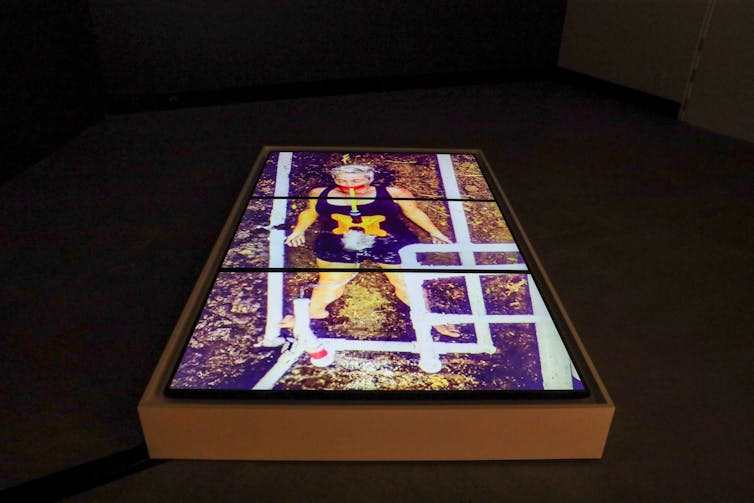 Libby Harward, BLOODLETTING (water-ways) 2021. 3-channel digital video, sound.
Courtesy of the artist. Photo Jo Driessens
Libby Harward, BLOODLETTING (water-ways) 2021. 3-channel digital video, sound.
Courtesy of the artist. Photo Jo Driessens
Quandamooka artist Libby Harward’s BLOODLETTING (water-ways) (2021) is a three-channel video installation lying horizontally on the floor. In an extraordinary self-portrait, Harward is lying in a life-sized trench (or shallow grave) and surrounded by PVC plumbing pipes.
The work is vaguely menacing: it is not clear to the spectator looking down at her how Harward is breathing through the apparatus duct taped to her mouth.
Harward’s work is both a timely and necessary contribution to a national conversation on First Nations’ water sovereignty.
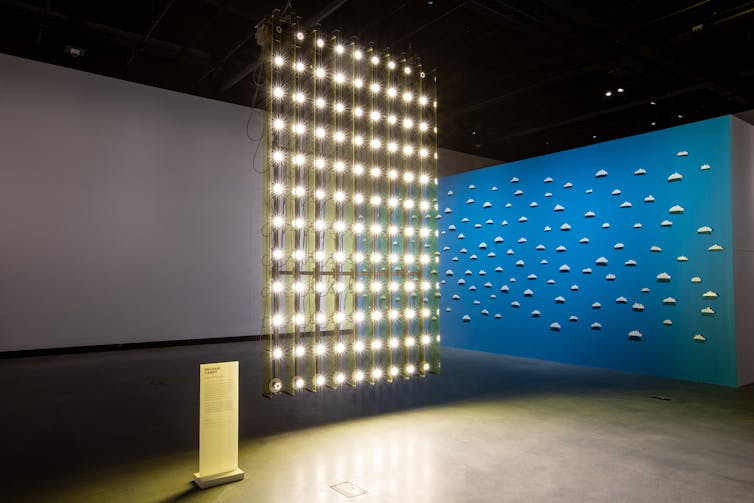 Pictured L-R: Front: Michael Candy, Steal the Sunshine 2021; Samuel Leighton-Dore Cloud-Drive 2021. SOLID GOLD: Artists from Paradise, HOTA Gallery.
Photo by Paul Harris Photography
Pictured L-R: Front: Michael Candy, Steal the Sunshine 2021; Samuel Leighton-Dore Cloud-Drive 2021. SOLID GOLD: Artists from Paradise, HOTA Gallery.
Photo by Paul Harris Photography
Michael Candy’s Steal the Sunshine (2021) is a testament to the artist’s skills in mechanical engineering, manufacturing and programming. Candy converts the sun’s natural light to artificial LED by simulating the sun’s daily path across a towering grid of lights.
The lights behave akin to a time-lapse video as the work responds to the changing light conditions outside the gallery.
Ali Bezer’s commanding floor sculpture, I Can Hear Water (2021), is formed by ripples and folds of aluminium and bitumen. Simultaneously a nod back to 1960s minimalist sculptures by artists such Carl Andre, as well as evoking the sights and sound of the Gold Coast’s beaches, Bezer’s work is both global in outlook while resolutely committed to its local environment.
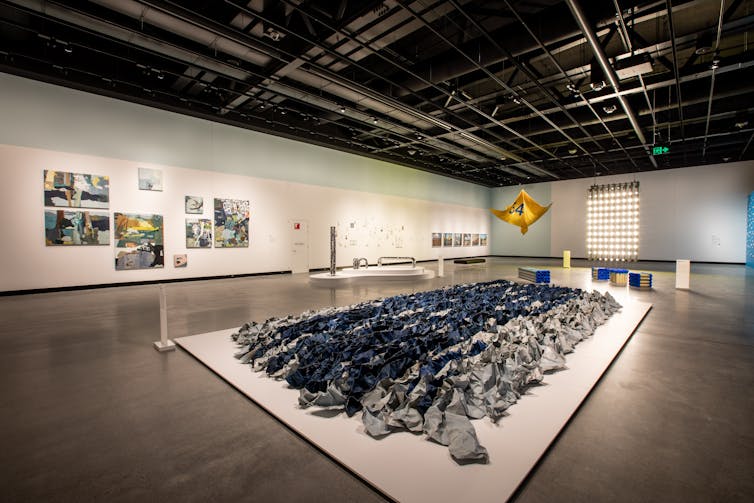 Back wall: Nicola Moss Local Air 2021; Kirsty Bruce Wonderwall 2021; Aaron Chapman The Towers Project 2021; Back right: Michael Candy, Steal the Sunshine 202; Front: Ali Bezer I Can Hear Water 2021; SOLID GOLD: Artists from Paradise, HOTA Gallery.
Photo by Paul Harris Photography
Back wall: Nicola Moss Local Air 2021; Kirsty Bruce Wonderwall 2021; Aaron Chapman The Towers Project 2021; Back right: Michael Candy, Steal the Sunshine 202; Front: Ali Bezer I Can Hear Water 2021; SOLID GOLD: Artists from Paradise, HOTA Gallery.
Photo by Paul Harris Photography
An ambitious space
The gallery is the new home to the Gold Coast council’s $32 million art collection. This permanent collection, on display in the upper levels, showcases key works by leading Australian artists. It reveals a variety of surprises and underscores a decades-long ambitious and forward-looking acquisition strategy.
Read more: Home of the Arts – inside an arts centre keeping body and soul together
Early, hard-edged abstractions by Michael Johnson from the 1970s are juxtaposed with feminist artist Julie Rrap’s Persona and Shadow: Virago (1984).
Tracey Moffatt’s important series Pet Thang (1991) is brought into dialogue with William Robinson’s The Rainforest (1990). Landscapes by Albert Tucker and Fred Williams are combined with Vernon Ah Kee’s wegrewhere (2009) series.
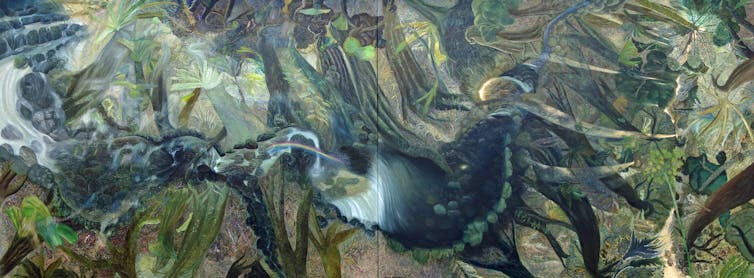 William Robinson’s The Rainforest, c 1900, is a centrepiece of the collection.
HOTA Gallery
William Robinson’s The Rainforest, c 1900, is a centrepiece of the collection.
HOTA Gallery
These conversations feel fresh and highlight the depth in the gallery’s collection — offering visitors new and unexpected connections, without feeling remotely regional or nostalgic.
For a city under constant renewal, from the new HOTA Gallery emerges a complex and dynamic negotiation of place.
SOLID GOLD: Artists from Paradise is showing at HOTA until 4 July.
Authors: Chari Larsson, Lecturer of art history, Griffith University





